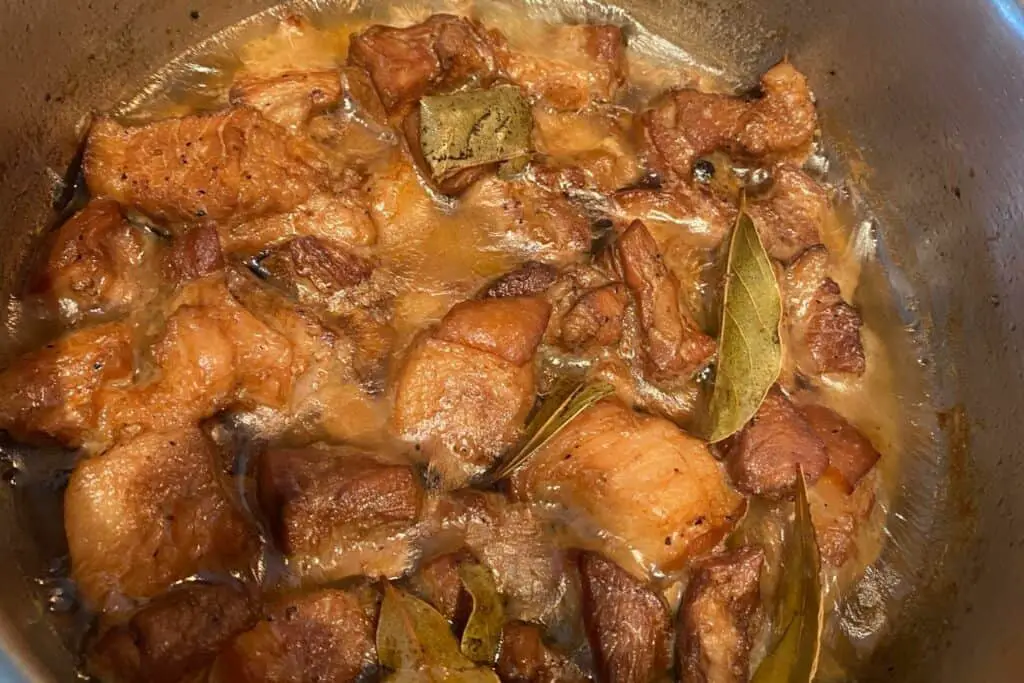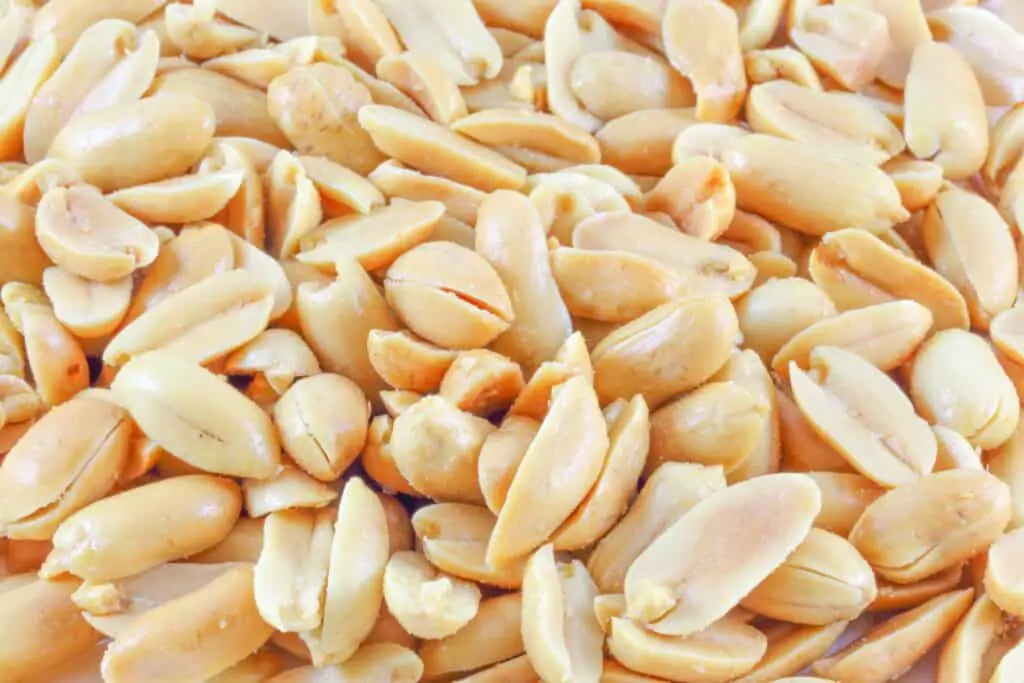
No matter how much you love adobo, sometimes, even the best people want a variety in the dishes they cook. Here we’ll talk about the ingredients that are sometimes added to adobo that are not necessarily used in authentic adobo.
Some ingredients that can be added to adobo are: coconut milk, potatoes, ginger, salt and onions. Although, these ingredients aren’t used in cooking traditional adobo, it is perfectly acceptable to add these ingredients when cooking this dish.
Want more information? Keep reading below.
Coconut Milk

Does filipino adobo have coconut milk? The answer is yes, sometimes.
While traditional adobo doesn’t usually have coconut milk, coconut milk can be added to adobo to give it a fresh, tropical taste. The result is something similar to coconut curry, and the salty taste of the adobo will be pared down a little bit with the addition of coconut milk.
When adding coconut as an ingredient to Filipino adobo, you can use three products of coconut: coconut oil, coconut milk and coconut vinegar. The best way to add a flavor of coconut into adobo is to add coconut milk.
Coconut milk is quite fatty, so its addition to adobo will result in a creamy texture. Typically, the meat used for this type of adobo is chicken, as using pork will have just that much more fat, which can be overwhelming, considering coconut milk consists mostly of fat.
Coconut milk is added to adobo by mixing it with soy sauce and vinegar, and then pouring the mixture into a pan where the meat of your choice is browning. This mixture will then be simmered until the chicken is fully cooked and the sauce reduced.
If you are looking to add a little twist to your adobo, why not try adding coconut milk next time you make it?
Potatoes

Does filipino adobo have potatoes? The answer is yes, most of the time.
Although filipino adobo traditionally does not have potatoes, it’s quite common to add potatoes to adobo. Adding potatoes to adobo is commonly done to add bulk to the dish and make the dish go farther, so to speak.
For example, when I was growing up in the Philippines, my mom would usually add potatoes to adobo when we didn’t have a lot of pork to cook in adobo. Adding potatoes instead of pork lowers the cost per serving of the dish significantly. I grew up eating adobo with potatoes, so now, growing up, I always look for the potatoes when I’m eating adobo.
Potatoes are added to adobo simply by peeling them and cutting them in quarters. Once the adobo is boiling and the meat is mostly cooked, the potatoes are added and left to boil for around 15 minutes or until it’s cooked.
Egg

Does filipino adobo have potatoes? The answer is sometimes.
Adding hardboiled egg in adobo is one of the easiest, fastest way of adding protein to the dish if you don’t have enough meat, or if the adobo is already cooked and you just want to add a little something to it.
For my family, apart from adding potatoes to adobo, the most common variation we do to adobo is to add hardboiled egg to it. It’s delicious, and the bland taste of the hardboiled egg compliments that sour and salty taste of adobo.
The way you can add egg to your adobo is to boil the egg separately in a different pot. Let it boil for seven minutes, or until the egg is hardboiled. Peel the egg and simply prop it on top of your cooked adobo. And just like that, you now have a dish that has additional protein, and the yolk adds a little creaminess to the dish.
Typing this is making my mouth water! Needless to say, I love eating my adobo with some hardboiled egg!
Salt

Does Filipino adobo have salt? Well technically, in the ingredients used, salt is present, but let me elaborate.
Salt is a present ingredient in soy sauce, the most popular salting agent used in Adobo. However, the use of salt in place of soy sauce is also done in practice in many places around the Philippines. This type of adobo is called “adobong puti“.
So in essence, adobo does always have salt. But in its history, did you know that salt was the main ingredient used instead of soy sauce? Soy sauce replaced the use of salt when it was introduced by the Chinese to the country.
Some people in the Philippines, particularly in the Visayas region still use salt instead of soy sauce in their adobo. I also personally still use salt instead of soy sauce when I run out of soy sauce and am in the middle of cooking adobo. The taste doesn’t differ much from adobo cooked with soy sauce. If you would like to change up your adobo, try using salt instead of soy sauce!
Nuts

Does Filipino adobo have nuts? No. Let me explain.
Adobo does not have nuts. The common ingredients used to cook adobo are: chicken or pork, soy sauce, vinegar, peppercorn, garlic and bay leaves. Some ingredients can be added to give it a slightly different flavor, but nuts are typically not one of them.
There is a common misconception that Filipino adobo contains nuts, when in fact it does not. Adobo is a dish that originates from the Philippines, and it typically consists of meat or seafood that has been cooked in a vinegar and soy sauce mixture. While ingredients can vary depending on region and personal preference, common additions to adobo include garlic, bay leaves, and peppercorns. Nuts are not a traditional ingredient in adobo, and they are not commonly used as a flavor enhancement. While some modern versions of adobo may include nuts for added texture or flavor, traditional recipes do not call for them.
Ginger

Does Filipino adobo have ginger? Typically, no. Let me explain.
As a general rule, Filipino adobo does not have ginger. However, ginger is sometimes used in cooking adobo to add a slight spicy flavor to this common dish.
Adobo is a dish that originates from the Philippines. There are numerous variations of adobo, but the most common ingredients include chicken, pork, garlic, onion, bay leaves and black peppercorns. While ginger is not a traditional ingredient in adobo, it can be used to add a bit of heat and spice to the dish. When adding ginger to adobo, it is important to use fresh ginger root for the best flavor. Grated ginger can be added directly to the marinade, or it can be cooked with the other ingredients. Either way, ginger is an easy way to add a bit of flair to this classic Filipino dish.
Onions

Does Filipino adobo have ginger? Yes, sometimes.
Onions can sometimes be added to adobo to add a layer of flavor to the dish. However, traditionally, adobo is not cooked with onions.
Adobo is a type of Filipino dish that is typically made with chicken or pork that has been stewed in a vinegar and soy sauce base. While there are variations of the dish, adobo does not traditionally include onions. Onions are sometimes added to adobo, but they are not considered to be part of the classic dish. Adobo is typically served with rice, and it can also be made into a soup by adding additional ingredients such as vegetables or noodles. While adobo is usually made with chicken or pork, it can also be made with shrimp, squid, or tofu. Adobo is a popular dish that is often served at parties and gatherings. It is also a popular dish to order when eating out at Filipino restaurants.

